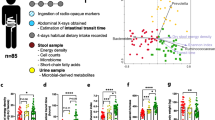Abstract
The objective of this study was to test the “dietary fiber theory of Western diseases” in Lagos, an area of relatively low prevalence, by investigating the relationship between fiber in diet, stool weight, and whole-gut transit rates in a sample of the population on an urban-type diet. A 5-day study of fiber in diet and stool weight in 9 normal subjects showed a positive correlation between stool weight and consumed fiber. A second 5-day study of the diet, whole-gut transit rates, and wet stool weight in 37 male students revealed that only 15% of the lunches and dinners consisted of staple foods rich in crude fiber, that the mean transit time for first marker was 24.8 hours (SD±10.8) and for 80% of the markers was 48.5 hours (SD±20.9), and that the mean stool weight was 143.3 gram (SD±48.5). There was a negative correlation between transit time and wet stool weight both for first and 80% of markers. The transit time was slower and the stool weight less than figures quoted for rural Africans, but was not significantly different from British figures. The consequences of adopting a sophisticated low fiber diet due to urbanization in rapidly developing urban communities are discussed. It is suggested that in order to prevent an increase in the incidence of colorectal “Western diseases,” a health education drive in urban areas highlighting the qualities of high fiber staple foods be instituted.
Résumé
Nous avons, dans la présente étude, essayé de tester la théorie des fibres alimentaires et son importance dans la pathogénie des maladies colorectales du monde occidental. L'étude a été faite à Lagos, où ces maladies sont relativement rares, sur un échantillon de population à régime alimentaire urbain, par une analyse des relations existant entre quantité de fibres dans le régime, poids des selles et transit digestif. Chez 9 sujets normaux, une étude de 5 jours des quantités de fibres dans le régime et du poids des selles montre une corrélation positive entre ces deux paramètres. Une seconde étude, faite sur 37 étudiants de sexe masculin, a porté sur le régime, le transit intestinal et le poids de selles humides: elle montre que 15% seulement des déjeuners et dîners comportent un régime riche en fibres, que le temps moyen de transit intestinal est de 24.8±10.8 heures pour la tête du marqueur et de 48.5± 20.9 heures pour 80% du marqueur, et que le poids moyen des selles est de 143.3 ± 48.5 gr. Il existe une corrélation négative entre le poids de selles humides et le temps de transit, tant pour la tête que pour les 80% du marqueur. Le temps de transit et le poids de selles humides sont inférieurs aux chiffres publiés pour les africains des campagnes, mais ne diffèrent pas de façon significative des données de la littérature britannique. Nous discutons les effets du passage à un régime pauvre en déchêts, conséquence de l'urbanisation dans les communautés urbaines à développement rapide. L'étude suggère que, pour prévenir le développement des maladies colorectales de type “monde occidental“, il faudrait organiser, dans les zones urbaines, un programme d'éducation sanitaire soulignant les qualités des régimes riches en fibres.
Similar content being viewed by others
References
Trowell, H.C.: Noninfective Diseases in Africa. London, Arnold, 1960
Painter, N.S.: Diverticulosis of the colon—a disease of this century. Lancet2:586, 1969
Trowell, H.C.: Western diseases, starchy foods, and fibre. Med. Dig.3:6, 1977
Burkitt, D.P.: Diet and disease; dietary fibre. R. Soc. Health J.95:186, 1974
Burkitt, D.P., Walker, A.R.P., Painter, N.S.: Effect of dietary fibre on stools and transit times, and its role in the causation of diseases. Lancet2:1408, 1972
Doll, R.: Epidemiology of carcinoma of colon and rectum. In Topics in Gastroenterology, Truelove, S.C., Lee, E., editors. London, Blackwell Scientific Publications (in press)
Ogunbiyi, T.A.J., Oyeneyin, J.O.: Carcinoma of the colon and rectum. Nig. Med. J.1:149, 1971
Platt, B.S.: Tables of representative value of foods commonly used in tropical countries. Medical Research Council Special Report, Series No. 302. London, Her Majesty's Stationery, 1971
Watt, B., Merril, A.: Composition of Foods. Agricultural Handbook No. 8. Washington, D.C., U.S. Dept. of Agriculture, 1963
Hinton, J.M., Lennard-Jones, J.E., Young, A.C.: A new method for studying transit times using radiopaque markers. Gut10:842, 1969
Bassey, O.O.: Fibre content of common Nigerian Foods. Proc. Nigerian Surg. Res. Soc. 2nd Scientific Meeting, June, 1977. West Afr. J. Surg. (in press)
Gelfand, M.: The pattern of diseases in Africa and the Western way of life. Cent. Afr. J. Med.21: 145, 1975
Bremner, C. G.: Ano-rectal disease in the South African Bantu. 1. Bowel habit and physiology. S. Afr. J. Surg.2:119, 1964
Painter, N.S., Burkitt, D.P.: Diverticular disease of the colon: a deficiency disease of Western civilization. Br. Med. J.2:450, 1971
Omo-Dare, P., Thomas, H.O.: Acute appendicitis in Lagos (An evaluation of the present situation). West Afr. Med. J.15:217, 1966
Ogunbiyi, T.A.J.: A review of haemorrhoids in Lagos University Teaching Hospital. Nig. Med. J. (in press)
Ajayi, O.O., Banigo, O.G., Nnamdi, K.: Anal fissure, fistula, abscesses and haemorrhoids in a tropical population. Dis. Colon Rectum17:55, 1974
Painter, N.S.: Diverticular disease of the colon. In Topics in Gastroenterology, 1st Edition, Truelove, S.C., Jewell, D.P., editors. London, Blackwell Scientific Publications, 1973, p. 294
Hill, M.J.: Steroid nuclear dehydrogenation and colon cancer. Am. J. Clin. Nutr.27:1475, 1975
Author information
Authors and Affiliations
Rights and permissions
About this article
Cite this article
Ogunbiyi, T.A.J. Whole-gut transit rates and wet stool weight in an urban Nigerian population. World J. Surg. 2, 387–392 (1978). https://doi.org/10.1007/BF01561528
Issue Date:
DOI: https://doi.org/10.1007/BF01561528




